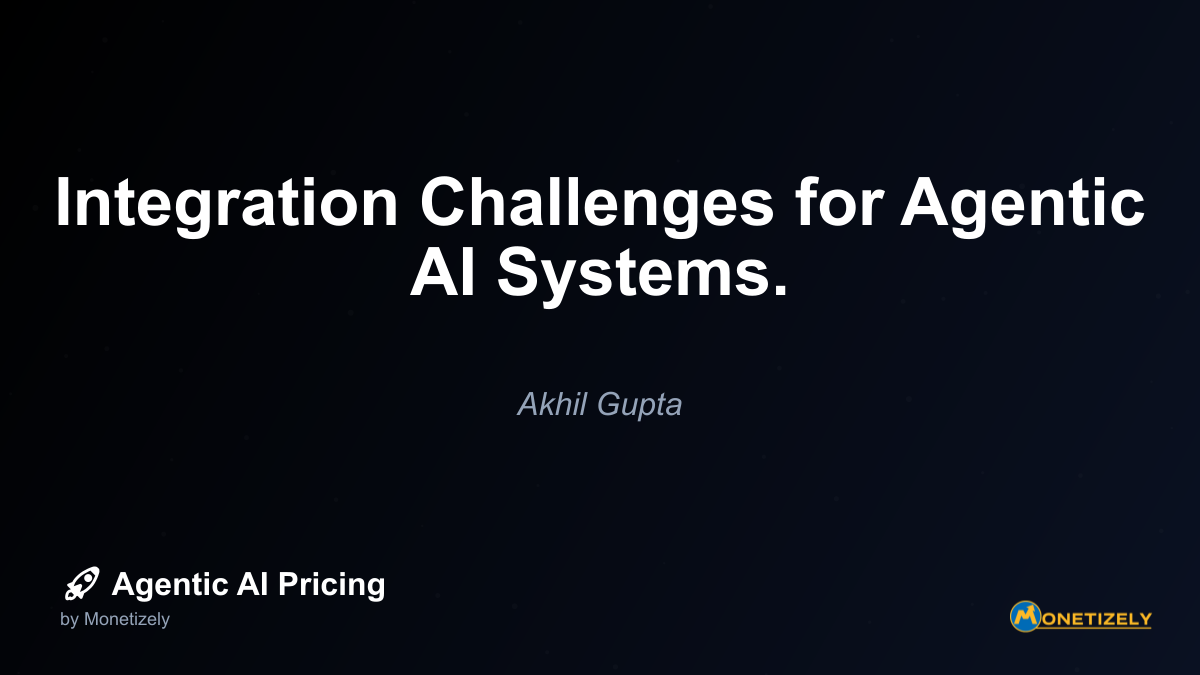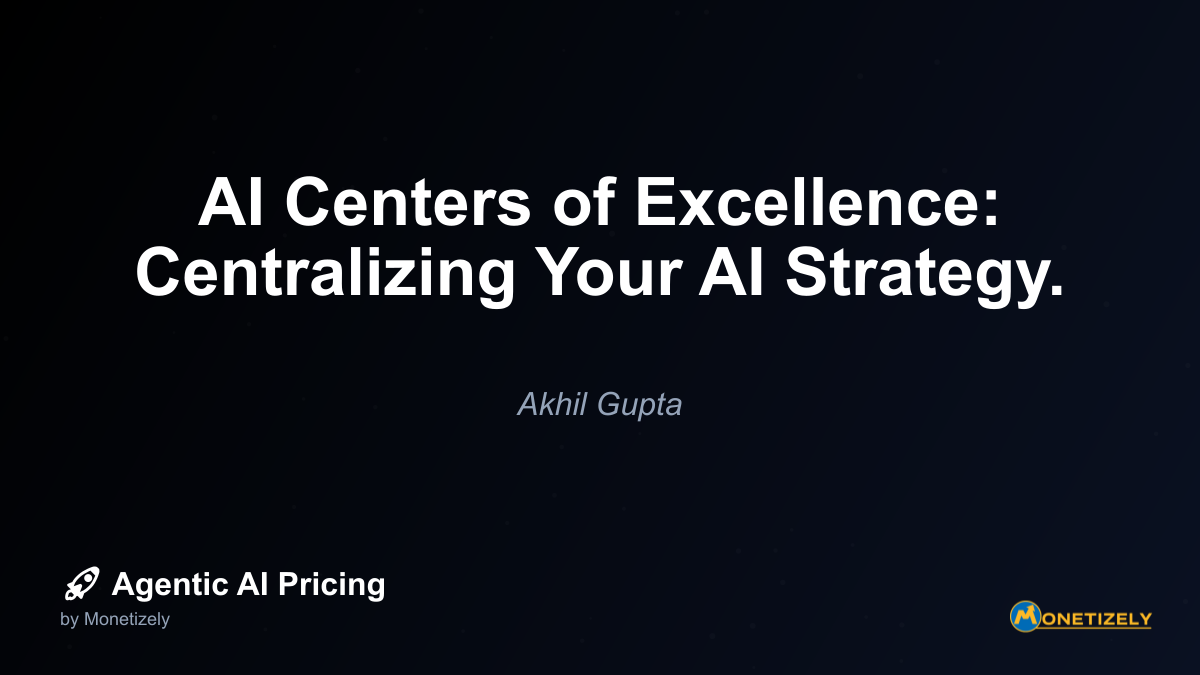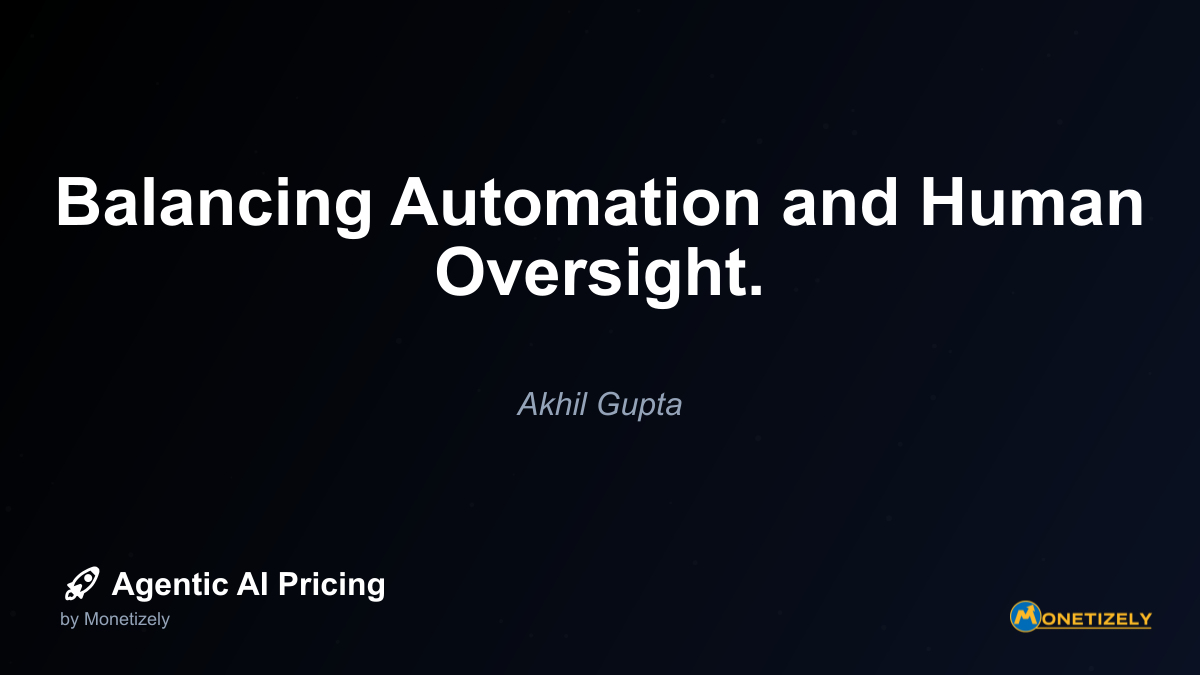· Akhil Gupta · Implementation Strategies · 11 min read
Integration Challenges for Agentic AI Systems.
AI and SaaS Pricing Masterclass
Learn the art of strategic pricing directly from industry experts. Our comprehensive course provides frameworks and methodologies for optimizing your pricing strategy in the evolving AI landscape. Earn a professional certification that can be imported directly to your LinkedIn profile.

In today’s rapidly evolving technological landscape, organizations are increasingly turning to agentic AI systems to gain competitive advantages, streamline operations, and enhance decision-making processes. However, the journey from recognizing the potential of agentic AI to successfully implementing it within existing infrastructures is fraught with challenges. These intelligent, autonomous systems that can perceive, reason, and act on behalf of users or organizations require thoughtful integration strategies to deliver their promised value.
The integration of agentic AI systems represents a multifaceted challenge that spans technical considerations, organizational dynamics, and human factors. Companies must navigate complex landscapes of legacy systems, data compatibility issues, and workforce adaptation while maintaining security and compliance standards. The road to successful AI integration is rarely straightforward, but with proper planning and awareness of common pitfalls, organizations can significantly improve their chances of success.
Understanding the Technical Integration Challenges
API Compatibility and System Architecture
One of the most immediate challenges organizations face when integrating agentic AI systems is establishing functional connections between these new technologies and existing infrastructure. Legacy systems, often built decades before the current AI revolution, weren’t designed with AI integration in mind.
The architectural differences between modern AI systems and legacy infrastructure create significant hurdles. Many legacy systems operate on monolithic architectures with tightly coupled components, while contemporary AI solutions typically leverage microservices and API-first designs. This fundamental mismatch can make direct integration complex and resource-intensive.
API compatibility issues frequently arise when agentic AI systems need to communicate with existing software. Organizations often discover that their current systems have limited or outdated APIs, or worse, no API capabilities at all. In such scenarios, companies must either develop custom middleware solutions or undertake the risky process of modifying legacy code to enable integration.
Additionally, many legacy systems operate with synchronous processing models, while AI agents may require asynchronous communication patterns to function optimally. This disconnect in processing paradigms can lead to performance bottlenecks, timeout issues, and degraded user experiences if not properly addressed during integration planning.
Data Compatibility and Quality Issues
Data represents the lifeblood of any AI system, and data-related challenges form a significant portion of integration difficulties. Organizations typically store data across multiple disparate systems with varying formats, schemas, and quality standards.
Agentic AI systems require consistent, high-quality data to function effectively. However, legacy systems often contain:
- Inconsistent data formats and naming conventions
- Duplicate or conflicting records
- Missing values and incomplete information
- Outdated or incorrect data
- Unstructured data that lacks proper tagging or organization
The process of data normalization, cleaning, and preparation for AI consumption can be extraordinarily time-consuming and expensive. According to industry estimates, data scientists typically spend 60-80% of their time on data preparation tasks before any actual model training or implementation can begin.
Furthermore, real-time data access presents another layer of complexity. Many agentic AI systems require immediate access to current information to make timely decisions. Legacy systems, however, may not support real-time data extraction or may experience performance degradation when subjected to frequent queries.
Infrastructure and Computational Requirements
Agentic AI systems often have substantial computational requirements that exceed the capabilities of existing IT infrastructure. These systems may need:
- High-performance computing resources for model training and inference
- Scalable cloud infrastructure to handle variable workloads
- Specialized hardware like GPUs or TPUs for specific AI tasks
- Low-latency networking for real-time decision making
- Robust storage solutions for large datasets and model artifacts
Organizations frequently underestimate the infrastructure investments required to support agentic AI systems effectively. This miscalculation can lead to performance issues, unexpected costs, and integration failures when existing systems cannot meet the demands of new AI capabilities.
Organizational and Process Integration Challenges
Workflow Disruption and Process Redesign
Beyond technical considerations, the integration of agentic AI systems often necessitates significant changes to established business processes and workflows. These intelligent systems don’t simply plug into existing procedures; they fundamentally transform how work gets done.
Organizations must carefully evaluate which processes are suitable for AI augmentation or automation. This evaluation requires deep understanding of both current workflows and the capabilities and limitations of the AI systems being implemented. Process redesign efforts must balance efficiency gains against disruption risks, ensuring that core business functions remain operational throughout the transition.
Workflow integration challenges are particularly acute in scenarios where agentic AI systems must collaborate with human workers. Determining appropriate handoff points between AI and human agents requires careful consideration of each party’s strengths and limitations. Poorly designed human-AI workflows can lead to confusion, duplicated effort, and missed opportunities for optimization.
Change Management and Employee Resistance
The human element of AI integration is perhaps the most underestimated aspect of implementation. Employee resistance to AI-driven change stems from various sources:
- Fear of job displacement or role diminishment
- Skepticism about AI capabilities and reliability
- Concerns about increased monitoring or control
- Reluctance to learn new systems and processes
- Cultural resistance to automation in general
Effective change management strategies must address these concerns directly while providing clear communication about the purpose and benefits of AI integration. Organizations that fail to invest in comprehensive change management often encounter passive resistance that can undermine even technically sound integration efforts.
Research consistently shows that successful AI implementations dedicate significant resources to training, communication, and organizational alignment. According to a McKinsey survey, companies that report successful AI adoption are 2.5 times more likely to have invested in change management and employee training programs compared to companies with failed implementations.
Governance and Decision-Making Authority
As agentic AI systems begin making or recommending decisions previously handled by humans, questions of governance and authority inevitably arise. Organizations must establish clear frameworks for:
- Who is responsible for AI-made decisions
- How to handle exceptions and edge cases
- When human intervention is required
- How to audit and review AI actions
- What escalation paths exist for problematic situations
The integration of AI decision-making capabilities into existing governance structures requires careful consideration of regulatory requirements, ethical guidelines, and organizational risk tolerance. Without clear governance frameworks, organizations risk creating accountability gaps that can lead to compliance issues and eroded trust in AI systems.
Security and Compliance Challenges
Data Privacy and Security Concerns
Agentic AI systems typically require access to sensitive business data and potentially personal information to function effectively. This expanded data access creates new security challenges and potential vulnerabilities that must be addressed during integration.
Organizations must implement robust security measures to protect:
- Data in transit between AI systems and legacy infrastructure
- Training data used to develop AI models
- Model parameters and weights that could be extracted or compromised
- Inference results that may contain sensitive information
- Access credentials and authentication mechanisms
The integration process itself can introduce security vulnerabilities if not carefully managed. Temporary access grants, development environments, and migration tools must all adhere to security best practices to prevent creating new attack vectors during implementation.
Regulatory Compliance and Ethical Considerations
As AI systems become more deeply integrated into business operations, they increasingly fall under regulatory scrutiny. Depending on the industry and geography, organizations may need to ensure their AI implementations comply with:
- Data protection regulations (GDPR, CCPA, etc.)
- Industry-specific requirements (HIPAA, FINRA, etc.)
- Emerging AI-specific regulations
- Anti-discrimination and fairness standards
- Transparency and explainability requirements
The challenge of maintaining compliance across integrated systems grows as AI capabilities expand into new domains. Organizations must develop comprehensive compliance strategies that account for both existing regulations and emerging requirements specific to AI technologies.
Ethical considerations present another layer of complexity. Even legally compliant AI systems may raise ethical concerns related to bias, fairness, transparency, and accountability. Organizations integrating agentic AI must develop frameworks for assessing the ethical implications of their implementations and establish governance mechanisms to address potential issues.
Strategies for Overcoming Integration Challenges
Adopting an Incremental Integration Approach
Rather than attempting wholesale replacement or integration of legacy systems with agentic AI, successful organizations typically adopt incremental approaches that deliver value while minimizing disruption.
Phased implementation strategies might include:
- Starting with non-critical processes to build experience and confidence
- Implementing AI capabilities as augmentation rather than replacement
- Creating parallel systems before full migration
- Developing proof-of-concept projects with clear success metrics
- Gradually expanding AI scope as integration expertise develops
This incremental approach allows organizations to learn from early implementation experiences, refine their integration methodologies, and build internal support through demonstrated successes before tackling more critical or complex integration challenges.
Building Robust Data Pipelines and Middleware
Given the centrality of data to AI performance, successful integration often hinges on developing robust data infrastructure that can bridge legacy systems and new AI capabilities.
Key components of effective data integration strategies include:
- Implementing data lakes or warehouses to centralize and normalize information
- Developing ETL (Extract, Transform, Load) processes tailored to AI requirements
- Creating API gateways to standardize access to legacy systems
- Establishing data governance protocols to ensure quality and consistency
- Implementing real-time data streaming capabilities where necessary
Organizations may need to develop custom middleware solutions that serve as translation layers between legacy systems and new AI capabilities. These middleware components can handle data format conversions, protocol translations, and caching to improve performance and reliability.
Investing in Comprehensive Training and Change Management
The human aspects of AI integration require as much attention as technical considerations. Organizations that successfully navigate integration challenges typically invest heavily in:
- Technical training for IT staff responsible for maintaining integrated systems
- Process training for employees whose workflows will change
- Leadership development to help managers guide teams through transition
- Cross-functional collaboration to break down implementation silos
- Open communication about implementation goals and progress
Change management strategies should address both rational and emotional responses to AI integration. This comprehensive approach includes clear articulation of the business case for integration, transparent communication about potential impacts, and opportunities for stakeholders to provide input on implementation decisions.
Establishing Clear Governance Frameworks
Successful AI integration requires well-defined governance structures that clarify roles, responsibilities, and decision-making authority across integrated systems.
Effective governance frameworks typically include:
- Clear ownership of AI systems and their outputs
- Defined escalation paths for exceptions and edge cases
- Regular review processes for AI performance and decisions
- Audit trails that document system actions and human interventions
- Feedback mechanisms to improve AI performance over time
These governance structures should evolve as AI capabilities mature and integration deepens. Organizations should regularly reassess governance frameworks to ensure they remain appropriate for current AI capabilities and organizational needs.
The Future of Agentic AI Integration
As agentic AI technologies continue to evolve, integration challenges will simultaneously grow more complex and benefit from emerging solutions designed specifically to address them. Several trends are likely to shape the future of AI integration:
API Standardization and Integration Platforms
The growing demand for AI integration is driving standardization efforts across the industry. We’re seeing the emergence of specialized integration platforms designed specifically to connect legacy systems with AI capabilities. These platforms offer pre-built connectors, standardized data transformation tools, and simplified workflow design features that can significantly reduce integration complexity.
As these platforms mature, organizations will benefit from reduced custom development requirements and more predictable integration timelines. Industry-specific integration solutions are also emerging, offering tailored approaches for sectors like healthcare, finance, and manufacturing.
Explainable AI and Trust-Building Technologies
One of the persistent challenges in AI integration is building trust in automated systems, particularly when they replace or augment human decision-making. Advances in explainable AI (XAI) technologies are making it easier to understand and communicate how AI systems reach their conclusions.
These explainability features will become increasingly important for successful integration, as they allow organizations to:
- Validate AI decisions against established policies and regulations
- Build employee trust in AI recommendations
- Provide necessary explanations to customers and regulators
- Identify and address potential biases or errors in AI reasoning
As explainable AI techniques mature, they will facilitate deeper integration by making AI systems more transparent and accountable to human stakeholders.
Adaptive Systems and Continuous Learning
Future agentic AI systems will increasingly adapt to organizational contexts rather than requiring organizations to adapt to them. These adaptive capabilities will include:
- Learning from user interactions to improve integration experiences
- Automatically adjusting to changes in underlying systems and data
- Self-monitoring for integration issues and performance problems
- Suggesting optimization opportunities based on usage patterns
This shift toward adaptive AI will reduce the ongoing maintenance burden of integrated systems and allow organizations to realize value more quickly from their AI investments.
Conclusion
The integration of agentic AI systems into existing organizational infrastructure presents a complex array of challenges spanning technical, organizational, and human dimensions. Organizations that approach these challenges with comprehensive strategies addressing both technical and cultural aspects of integration are most likely to succeed in their implementation efforts.
Key takeaways for organizations embarking on agentic AI integration include:
- Recognize that successful integration requires attention to both technical and human factors
- Adopt incremental approaches that build experience and demonstrate value
- Invest in robust data infrastructure as a foundation for AI capabilities
- Develop comprehensive change management strategies to address resistance
- Establish clear governance frameworks that evolve with AI capabilities
- Prepare for continuous adaptation as both AI technologies and business needs evolve
By acknowledging and proactively addressing integration challenges, organizations can maximize the transformative potential of agentic AI while minimizing disruption to existing operations. The path to successful integration may be challenging, but the competitive advantages and operational improvements offered by well-implemented AI systems make the journey worthwhile for forward-thinking organizations.
As agentic AI continues to evolve, so too will integration approaches and technologies. Organizations that develop integration capabilities today will be well-positioned to adapt to future advancements and maintain competitive advantage in an increasingly AI-driven business landscape.
Co-Founder & COO
Akhil is an Engineering leader with over 16+ years of experience in building, managing and scaling web-scale, high throughput enterprise applications and teams. He has worked with and led technology teams at FabAlley, BuildSupply and Healthians. He is a graduate from Delhi College of Engineering and UC Berkeley certified CTO.
Pricing Strategy Audit
Let our experts analyze your current pricing strategy and identify opportunities for improvement. Our data-driven assessment will help you unlock untapped revenue potential and optimize your AI pricing approach.




